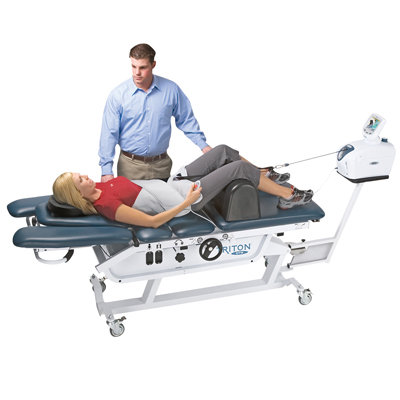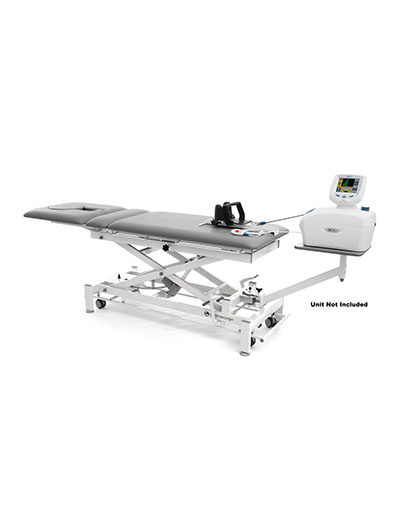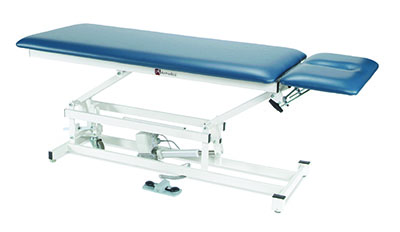 9th Jul 2024
9th Jul 2024
Unlocking the Benefits of a Physical Therapy Traction Table: Accelerate Recovery and Restore Mobility
Are you looking to accelerate your recovery from an injury or condition of the spine of other select musculoskeletal condition? Are you in search of a solution that can help alleviate pain, restore mobility and promote healing? This is the purpose of a physical therapy or chiropractic traction/decompression table.
Incorporating innovative technology and therapeutic techniques, a therapy traction table can deliver a myriad of benefits for patients undergoing rehabilitation. By gently stretching and decompressing the spine or affected joints, this specialized equipment helps to relieve pressure and alleviate discomfort.
But the benefits go beyond pain relief. Regular use of a traction table can facilitate improved circulation, enhance flexibility, and restore range of motion. It can also promote the healing process by reducing inflammation and facilitating the flow of nutrients to the affected areas.
Whether you're recovering from a back injury, a herniated disc, or chronic joint pain, a physical therapy traction table can be a game-changer on your rehabilitation journey.
Understanding the role of a physical therapy traction table

Physical therapy traction tables are specialized pieces of equipment used in the rehabilitation and treatment of various musculoskeletal conditions. These tables are designed to gently stretch and decompress the spine or affected joints, providing a range of therapeutic benefits for patients.
At the core of a physical therapy traction table's function is the ability to create a controlled, gradual pulling force on the body. This “traction”, or “stretching”, helps to relieve pressure on the spine, discs, and joints, which can be particularly beneficial for individuals suffering from conditions such as herniated discs, spinal stenosis, and chronic joint pain.
By applying this gentle, targeted traction, physical therapy and chiropractic traction tables can help to improve circulation, enhance flexibility, and restore range of motion. This, in turn, can accelerate the healing process, reduce inflammation, and promote the flow of nutrients to the affected areas. Ultimately, the role of a therapy traction table is to reduce pain and facilitate the body's natural healing processes and help patients regain their mobility and function.
Benefits of using a traction table for physical therapy
One of the primary benefits of using a physical therapy traction table is its ability to alleviate pain and discomfort. By decompressing the spine or joints, the traction table can help to relieve pressure on the nerves and reduce the intensity of pain experienced by the patient. This can be particularly helpful for individuals dealing with conditions such as sciatica, degenerative disc disease, or osteoarthritis.
In addition to pain relief, physical therapy traction tables can also improve flexibility and range of motion. The gentle stretching and decompression provided by the table can help to increase the mobility of the affected joints and muscles, allowing patients to regain their full range of movement. This can be especially beneficial for individuals who have experienced a loss of mobility due to an injury or chronic condition.
Another significant benefit of using a physical therapy traction table is its potential to enhance the healing process. By improving circulation and promoting the flow of nutrients to the affected areas, the traction table can help to reduce inflammation and facilitate the body's natural healing mechanisms. This can be particularly useful for patients recovering from acute injuries, such as sprains or strains, as well as those dealing with chronic conditions that require ongoing management.
How a traction table accelerates recovery
The key to how a physical therapy traction table accelerates recovery lies in its ability to address the underlying causes of pain and dysfunction. By applying a controlled, gradual pulling force on the body, the traction table can help to relieve pressure on the spine (and associated nerves), discs, and joints, which can be a significant contributing factor to many musculoskeletal conditions.
As the traction table gently decompresses the affected areas, it can help to improve circulation and promote the flow of nutrients to the injured or inflamed tissues. This, in turn, can facilitate the body's natural healing processes, reducing inflammation and accelerating the recovery timeline.
Moreover, the increased mobility and flexibility achieved through the use of a physical therapy traction table can play a crucial role in accelerating recovery. By restoring range of motion and improving the function of the affected joints and muscles, patients can more easily engage in targeted exercises and rehabilitation activities, further enhancing their progress.
Restoring mobility with the help of a traction table
One of the primary ways a physical therapy traction table can help restore mobility is by addressing the underlying issues that are limiting a patient's range of motion. Whether it's a herniated disc, joint adhesion, or muscle tightness, the traction table's ability to gently stretch and decompress the affected areas can help to alleviate the sources of mobility restrictions.
As the traction table works to improve circulation and reduce inflammation, it can also help to enhance the flexibility of the muscles and connective tissues surrounding the affected joints. This increased flexibility can translate to a greater range of motion, allowing patients to regain better use of their spine and limbs and improve their overall mobility.
In addition to the direct benefits of traction, the use of a therapy traction table can also facilitate the effectiveness of other rehabilitation exercises and therapies. By preparing the body for movement and reducing pain and discomfort, the traction table can enable patients to engage more fully in activities such as stretching, strengthening, and balance training, further enhancing their mobility and functional abilities.
Types of traction tables used in physical therapy

Physical therapy traction tables come in a variety of designs and configurations, each tailored to address specific needs and conditions. One of the most common types is the cervical traction table, which is designed to provide gentle stretching and decompression to the neck and upper spine. These tables are often used to treat conditions such as herniated discs, pinched nerves, and cervical spondylosis.
Another popular type of traction table is the lumbar traction table, which focuses on the lower back and hips. These tables are particularly useful for patients dealing with low back pain, sciatica, and degenerative disc disease. By applying traction to the lumbar region, the table can help to alleviate pressure on the discs and promote the flow of nutrients to the affected areas.
In addition to cervical and lumbar traction tables, some physical therapy clinics may also offer tables designed for the treatment of specific joints, such as the knee or ankle. These specialized tables can be used to address conditions like osteoarthritis, sprains, and other joint-related injuries, providing targeted traction and decompression to the affected area.
Precautions and safety measures when using a traction table
While physical therapy traction tables are generally safe and effective when used under the guidance of a qualified healthcare professional, there are some important precautions and safety measures to consider. First and foremost, it is essential that patients undergo a thorough evaluation by a physical therapist, chiropractor or other healthcare provider to ensure that the traction table is an appropriate and safe treatment option for their specific condition.
Individuals with certain medical conditions, such as severe osteoporosis, spinal cord injuries, or certain types of cancer, may not be suitable candidates for traction table therapy. It is crucial that the healthcare provider carefully assess the patient's medical history and current health status before recommending the use of a traction table.
During the traction table session, it is important for the patient to communicate any discomfort or pain they may experience to the healthcare provider. The traction force should be gradually increased and adjusted based on the patient's tolerance and response. Exceeding the patient's comfort level or applying too much traction force can potentially cause further injury or exacerbate the existing condition.
Incorporating traction table exercises into your physical therapy routine
In addition to the direct benefits of traction table therapy, many therapists also incorporate targeted exercises and activities into the rehabilitation process to further enhance the patient's recovery and mobility. These exercises may be performed on the traction table itself or as part of the overall physical therapy routine.
For example, a physical therapist may guide the patient through gentle stretching and range-of-motion exercises while they are positioned on the traction table. A chiropractor may perform manual adjustment strategies while their patient is positioned on a traction table. These therapeutic interventions can help to relieve adhesions, improve flexibility and promote the flow of nutrients to the affected areas. Additionally, the therapist may incorporate strengthening exercises, such as core stabilization or lower body strengthening, to help the patient regain muscle function and stability.
In some cases, a therapist may also incorporate balance and proprioception exercises into the traction table routine. These exercises can help to improve the patient's overall coordination and body awareness, which can be particularly beneficial for those recovering from neurological or musculoskeletal injuries. By integrating these targeted exercises into the traction table therapy, the therapist can create a comprehensive rehabilitation plan that addresses the patient's specific needs and goals.
Finding the right physical therapy clinic with traction table services
When seeking out physical therapy or chiropractic services that incorporate the use of a traction table, it is important to do your research and find a clinic that is well-equipped and staffed with experienced healthcare professionals. Look for physical therapy clinics that specialize in the treatment of musculoskeletal conditions and have a reputation for providing high-quality, personalized care.
During your initial consultation, be sure to ask about the clinic's experience with traction table therapy and the specific types of traction tables they have available. It is also important to inquire about the qualifications and training of the therapists who will be overseeing your treatment. Experienced and knowledgeable healthcare providers are essential to ensuring the safe and effective use of a traction table.
Additionally, consider the overall environment and atmosphere of the therapy clinic. Look for a facility that is clean, well-maintained, and equipped with modern, well-functioning equipment. A positive and supportive environment can go a long way in helping patients feel comfortable and engaged during their rehabilitation process.
Conclusion: The importance of a traction table in physical therapy recovery

In conclusion, a therapeutic traction table is a versatile and invaluable tool in the rehabilitation and treatment of a wide range of spinal, neurological, and musculoskeletal conditions. By providing gentle, controlled traction and decompression, this specialized equipment can help to alleviate pain, improve flexibility, and accelerate the body's natural healing processes.
Whether you are recovering from an acute injury, managing a chronic condition, or simply seeking to improve your overall mobility and function, incorporating physical therapy or chiropratic traction table treatment into your rehabilitation routine can be a game-changer. By unlocking the benefits of this therapeutic tool, you can take a proactive step towards regaining control of your physical well-being and achieving your recovery goals.
As you embark on your journey to better health and mobility, remember the importance of working with experienced and qualified healthcare professionals who can guide you through the safe and effective use of a therapy traction table treatments. With their expertise and support, you can unlock the full potential of this remarkable therapeutic tool and experience the transformative power of traction table therapy.





